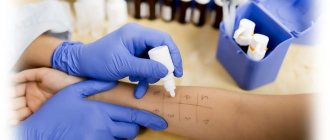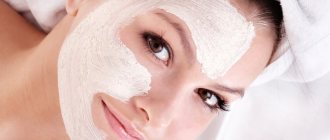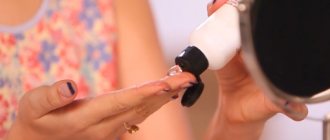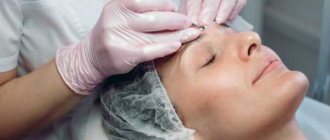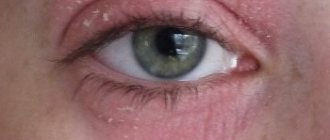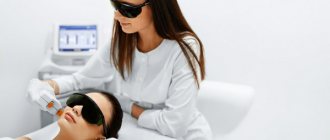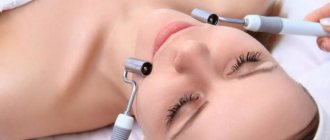One of the most common questions that a cosmetologist hears is: “After cleansing the face, how many days does the redness go away, when does the swelling go away?” Even the most qualified specialist will not be able to answer these questions unequivocally. There are a number of reasons that can aggravate the unpleasant consequences of the procedure.
Firstly, these are the characteristics of the cosmetologist’s patient’s dermis. If you are prone to acne, then the formation of pimples and inflammatory elements cannot be avoided. If the epidermis is hypersensitive, then redness may linger for more than three days.
The second reason for side effects of the procedure may be the unprofessionalism of the cosmetologist. Too much pressure during the cleansing process can cause the formation of wounds and hematomas. Insufficiently thorough cleaning of hands, skin, and tools can provoke infection and the formation of inflammation.
Possible consequences after facial cleansing and their causes
Cosmetologists warn their patients that after the procedure they may encounter some undesirable consequences. At its core, cleansing refers to a series of aggressive, even traumatic procedures. During the first 24 hours after it, the woman is likely to observe a reaction in the form of redness and slight swelling. This is considered a normal variant and does not require specific therapy.
Unpleasant consequences include the following:
- The formation of inflammatory elements or pimples. If sterility is maintained, this should not happen. The appearance of acne may indicate that the procedure caused the formation of a wound that became infected.
- Redness of the skin. Persistent redness that occurs after cleansing the face, which does not go away for more than 3 days, should alert you. Mechanical impact on the epidermis provokes a rush of blood and redness, which usually goes away after a few days.
- Formation of hematomas. This side effect indicates excess pressure when exposed to the problem area of the dermis.
- Edema. Swelling immediately after mechanical impact is considered normal. However, if after cleansing your face swelling appears and does not go away after three days, this is a reason to seek help from a specialist.
- Wounds and scars can occur if you have sensitive skin or unprofessional cleaning.
- Allergies occur when there is a hypersensitivity reaction to drugs used in cleaning.
Temporary discomfort after peeling
Peeling is an excellent option for quick, productive skin renewal. After the cleansing procedure, a number of changes occur in the cells of the skin, they begin to function rapidly, a large amount of collagen and elastin are produced, and many new, elastic and strong cells appear. Externally, changes are also noticeable, the skin becomes elastic, the face looks refreshed and younger.
The peeling procedure is one of the most popular methods of skin rejuvenation and healing. Unfortunately, most patients pay more attention to the end result, forgetting about the transformation process itself. Peeling does not end with a visit to the beauty salon. After exfoliation, the skin undergoes complete degeneration, which is accompanied by redness, swelling and peeling.
What natural and unpleasant skin consequences should you expect after the peeling procedure?
Red face
Redness is a completely understandable phenomenon after exfoliation. It almost always appears, but does not require additional intervention or action to eliminate it. Peeling is a stress for the skin, which stimulates the activity of epidermal cells and causes increased blood circulation in the upper layers of the skin. The patient's body instantly reacts to extensive tissue damage by intensifying regeneration processes and a rush of blood to the epidermis.
In medical language, a sudden rush of blood to the upper layers of the skin, due to physical impact, massage, is called erythema. There is no need to worry about this defect; it will go away on its own over time. The duration of redness depends on many factors, including the depth and type of exposure.
The intensity and duration of redness depends on the type of peeling chosen:
- After hardware peeling (laser, microcurrent), slight redness is observed, which quickly passes. It is worth noting that hardware peeling does not violate the integrity of the skin, the procedure takes place without complications, only problem areas are involved;
- After mechanical cleansing (after coral peeling, scrub, brosage), redness can persist for up to several hours;
- Chemical peeling causes an extensive burn on the surface, so the effect is more pronounced. For example, after a mid-peel with trichloroacetic acid, a reddened face may not go away for 5 days until the epithelization process is completed.
In the first minutes after peeling, the face becomes very red and burns. There is no cause for concern when you observe a tendency for redness to gradually fade. However, if unusual redness persists for a long time (several days) without changes, contact a cosmetologist.
You cannot mask redness with foundation, powder and other decorative cosmetics. This can contribute to the development of inflammation and infection of damaged tissues.
Swelling
Tissue swelling is usually observed in the corners of the lips and in the eye area. In these areas, the skin is thinner and sensitive to chemical and mechanical influences. Swelling is more typical for medium and deep peeling.
If the swelling does not go away within the time period prescribed by the peeling procedure protocol, you need to contact a cosmetologist. There are cases when swelling is caused by a violation of lymph outflow or is the body’s reaction to a component used during cleansing. Special procedures and massage can correct the situation, but you cannot prescribe or perform them yourself.
Peeling skin
After peeling, the skin begins to peel and peel. This is how the body gets rid of dead cells, replacing them with new ones. The peeling process lasts 2–7 days, it depends on the degree of exposure to the exfoliant and the structure of the skin. During the period of peeling, there is a feeling of tightness, unusual dryness, and itching is possible.
There is peeling without peeling. As a rule, this applies to the first cleansing procedure. There is no need to worry, there is simply nothing to peel off. Your skin has accumulated enough keratinized layers, the peeling agent has worked on the upper ones (you washed them off with an exfoliant), but has not yet reached the inner ones. With subsequent peeling procedures this will be corrected, and peeling will certainly occur.
To ease peeling of the skin after peeling, pay maximum attention to moisturizing: use drugs prescribed by a cosmetologist to accelerate regeneration, panthenol, products based on vegetable oils (shea butter, grape seed extract), cosmetics with the addition of hyaluronic acid.
Before using any new drug or skin care product after peeling, be sure to consult a cosmetologist. Some drugs can be harmful and prolong the rehabilitation period.
After undergoing peeling, patients face an equally important and alarming period of rehabilitation and recovery. The final result depends on how carefully you pay attention to the new skin condition, what you do and how.
When the patient is not sufficiently prepared for the cleansing procedure, there are problems with exfoliation, the peculiarities of the body’s condition are missed, contraindications - it’s difficult to talk about a positive outcome. In this case, complications may arise that require qualified intervention and additional examination.
water bubbles
The appearance of water bubbles on the surface of the face is a sign of a violation of the procedure protocol; perhaps the concentration of the peeling agent was exceeded, resulting in a deep chemical or thermal burn. Leave the situation to a cosmetologist to correct the situation. Seek help immediately, otherwise scars and age spots may remain on your face.
Frequent rashes, acne
Numerous rashes are a completely normal reaction to weakened immunity and the protective function of the skin, but they can also be caused by insufficient care. Numerous, extensive areas provoke residual atrophic scars.
Due to the weakening of the protection of skin cells from external attacks of infection and bacteria, herpes may appear and develop on the face. To reduce the risk of such complications, the cosmetologist recommends using antibiotics and antiviral drugs for some time after peeling.
Allergic reaction
Irritation, swelling and redness that do not go away for a long time are some of the signs of an allergic reaction. To avoid additional difficulties during and after peeling, it is important to carry out an allergy test in a timely manner and notify the cosmetologist about possible risks. If you have sensitive skin, then use anti-allergenic cosmetics after peeling.
When you cannot avoid allergies, immediately contact a cosmetologist. He will prescribe antihistamines in the form of injections or tablets, and recommend a special ointment to reduce allergy outbreaks.
Residual scars and scars
Improper care and violation of hygiene rules during the rehabilitation period can lead to residual scars. A day after exfoliation, peeling is observed on the face, in some cases a crust will appear. It should come off by the 7th day maximum, but you can’t tear it off or rip it off.
To speed up the process of tissue restoration, cosmetologists prescribe special wound-healing drugs, panthenol. You can additionally speed up regeneration with natural masks and products (shea butter, moisturizing compositions with hyaluronic acid, plant extracts).
Hyperpigmentation
The sun's rays, in particular ultraviolet radiation, negatively reflect on renewed skin. Its protective function has not been restored, so it is strongly recommended to perform peelings during the period of minimal solar activity (from October to February), plus include sunscreens in post-peeling care.
For those with skin prone to pigmentation, it is necessary to undergo pre-peeling preparation. Be sure to familiarize your cosmetologist with this fact.
How quickly does the redness go away?
During the process of mechanical facial cleansing, an intense effect on the epidermis occurs. As a result, peripheral blood circulation increases and redness occurs on the surface of the dermis. Its intensity and duration depend on the individual characteristics of the patient’s body.
A natural question that arises in the mind of every woman who sees her face after mechanical skin cleansing: how many days does the redness go away? Normally, hyperemia of the epidermis should last no more than three days. If after this period the redness does not go away, then you should definitely consult a doctor. He will select individual therapy. Often, when redness occurs, it is recommended to use ointment with dexpanthenol, as well as make compresses with chamomile or aloe Vera juice.
Which rashes after brushing are considered normal and which are not?
Experienced cosmetologists say: the formation of small superficial pimples after mechanical cleansing is natural and does not pose any danger. Thus, the epidermis gets rid of accumulated impurities and toxins. After vacuum or chemical cleaning, a layer of keratinized scales is removed from the epidermis and inflammation becomes more noticeable, pimples form faster.
In some cases, rashes on the face after cleansing are dangerous:
- the appearance of brightly colored red areas on the skin, similar to a rash, can be the result of a chemical burn;
- small pustules and itching of the skin are a sign of an allergic reaction to products used to treat the face or instrument, or to sunscreen;
- subcutaneous acne can be caused by the use of an excessively greasy product during mechanical cleansing, which is not suitable for the patient’s skin type.
Attention! Squeezing pimples and blackheads is strictly not recommended. There is a high risk of serious complications.
If the above warning signs are detected, you should stop self-medicating and consult a qualified dermatologist.
Ultrasonic cleaning or mechanical cleaning - what to choose
Ultrasonic cleaning is called a modern alternative to mechanical cleaning, but, according to the expert, this statement is not entirely true. Ultrasonic cleaning, which is carried out with a special spatula, removes dirt only from the surface of the epidermis, while it will not help get rid of deep dirt.
In each case, the specialist will recommend the optimal technique for the patient. For normal skin without noticeable pores or impurities, an ultrasonic spatula may be sufficient. But if you have comedones and deeply clogged pores, professional hand work is the only way to remove these imperfections.
Proper care after the procedure
The success of facial cleansing largely depends on how a woman follows skin care recommendations. Often cosmetologists supplement Metrogyl cleansing with gel and this gives a good effect. However, the use of antibiotics is not always justified or appropriate. Then cosmetologists advise the following actions:
- Wash your face with melt water or mineral water. You can also add lemon juice and apple cider vinegar to the solution. In this way, the surface of the epidermis is acidified and many problems with inflammation are solved.
- During the rehabilitation period, pamper your skin with fortified cocktail compositions for facial skin.
During the process of cleansing the face and in the subsequent rehabilitation period, compliance with these rules will minimize or avoid the formation of inflammatory elements:
- meticulously maintain cleanliness of skin, hands and tools;
- choose your favorite skin care products that suit your skin type;
- do not abuse cosmetic products with comedogenic effects;
- reduce your time in the sun;
- adjust your diet by eliminating junk food and enriching it with vegetables and fruits.
What is not recommended?
At the moment when the face begins to heal after cleansing, a woman should limit herself to a number of procedures. This is a list of actions that absolutely cannot be performed after cleaning:
- for 2-3 days, minimize exposure to the street, do not wash your face, and avoid any exposure to the skin;
- for a week refuse to visit the bathhouse, sauna, swimming pool;
- do not wash your face with hot water or chlorinated tap water;
- do not drink alcoholic beverages;
- do not exfoliate the skin using scrubs;
- do not injure the skin mechanically;
- do not use creams with natural ingredients to avoid an allergic reaction;
- do not wash your face with soap, which dries out the epidermis and leads to the formation of cracks;
- Do not overload your skin with cosmetic products.
Mechanical facial cleansing at home
“It will not be possible to carry out this cleansing at home in the classic form,” comments cosmetologist Isabella Airapetova. — You need a magnifying lamp that allows you to highlight the skin and enlarge fragments. You need professional cosmetics that are not available in regular stores. And finally, we need a second person to work on the face.”
Instead of trying the procedure at home, the specialist advises changing your daily skincare routine to improve the condition of oily skin and reduce the need for cleansing. To do this, you can use medicinal cosmetics available in pharmacies, and the daily care ritual should include several stages:
- cleansing - washing thoroughly in the morning and evening;
- toning - use toners for oily skin;
- exfoliation - instead of scrubs that injure the skin, choose peeling rollers without abrasive. These are creamy compositions that are applied to the face, left until dry, and then rolled together with dead skin particles, exfoliating the top layer of the epidermis.
It is useful to exfoliate once or twice a week, and after it apply a mask - antiseptic or pigment-constricting. If necessary, you can remove several blackheads from softened skin, but it is better not to touch the pores with your hands, as there is a high risk of injuring the epidermis and getting an unsightly mark on the face.
What is possible?
In order to minimize the negative consequences of mechanical facial cleansing, you can use gentle cosmetic procedures:
- Darsonval - electrical stimulation of the epidermis, improving regenerative processes. It is completely safe, does not cause discomfort and effectively helps eliminate redness, swelling and inflammation.
- Cryomassage is the effect of liquid nitrogen on the epidermis. The effect is noticeable after the first procedure: the skin calms down, the discomfort goes away.
- The use of homemade masks based on herbs: chamomile, plantain, celandine and calendula. Good ingredients include cucumbers, clay, egg, lemon, bodyaga, coffee grounds, kefir, and yeast.
Which cosmetic procedures to choose
How to get rid of acne spots quickly? It is best to immediately make an appointment with a cosmetologist; this is the most reliable way to quickly get rid of acne marks. A specialist will perform an inspection. He will assess the area of skin with defects and then choose the most appropriate procedure.
The best specialists in the cosmetics industry are working to invent new, low-traumatic ways to eliminate skin defects. Today medicine is at a high level, so society can use hardware procedures. Of course, they are quite expensive, but they are highly effective.
How to lighten stains? Modern cosmetology has in its arsenal a large selection of post-acne treatment methods. Peeling has proven itself to be excellent. The following types can be distinguished:
- dermabrasion (mechanical peeling);
- chemical (it can be deep and middle);
- laser.
How to remove acne spots? Peels help exfoliate and dissolve stagnant stains. If there are a lot of acne marks and significant unevenness, laser peeling or mechanical resurfacing is usually prescribed. The procedures are performed under local anesthesia; they are quite painful, but very effective.
How to get rid of acne marks? It is best to contact a cosmetologist or dermatologist at a large cosmetology center. Laser and mechanical resurfacing will remove acne marks that cannot be eliminated in any other way. The procedure is offered by clinics and beauty salons.
You can quickly remove acne spots on your face using chemical peeling. During the procedure, the doctor applies a weak acid solution to the skin. To remove acne spots, lactic acid, salicylic acid, or grape acid can be used. They act softly.
As a result of chemical peeling, the top layer of skin is exfoliated and collagen begins to be produced faster. After the procedures, the skin is evened out and its tone noticeably improves.
When they talk about mechanical peeling, they mean dermabrasion or microdermabrasion. In the first case, the top layer is removed with small brushes that rotate at high speed. The procedure helps to get rid of the marks left by acne, but you need to take into account that it is painful.
Microdermabrasion uses aluminum oxide on the skin to remove dead cells. This peeling is less traumatic. In order to achieve a significant improvement in skin condition, the doctor performs one to several procedures.
How to get rid of acne scars? You can choose laser polishing. The procedure involves the doctor directing a beam to areas of damaged skin. Blood does not come out, because the vessels are “sealed” instantly.
Laser resurfacing requires local anesthesia and the procedure lasts about 30 minutes. Usually the desired effect can be achieved in several visits to the doctor. The frequency between procedures is from 1 to 2 months.
How to get rid of acne scars? Darsonvalization perfectly removes stagnant spots; this method is classified as physiotherapeutic. The doctor uses high-frequency alternating current in his work, but its magnitude is very small. This is enough to get rid of dark spots.
The electrode is passed over the problem area of the skin. Darsonvalization perfectly resolves subcutaneous inflammation. The procedure is accompanied by a characteristic ozone smell. Sessions can be done every other day, the duration of one can be up to 15 minutes.
In order to remove scars, you need from 10 to 15 sessions. Since the skin may dry out after darsonvalization, the procedure is completed by applying a moisturizer.
You can remove acne marks with collagen injections. But their effect is temporary, so the procedure will need to be repeated after 6 months.
Mesotherapy against acne marks
In addition to the procedures described above, mesotherapy is used to remove dark spots left by acne. During the procedure, the doctor injects medications into the problem area. Since they are used in high concentrations, the positive effects are immediate. Metabolism accelerates and the rate of skin regeneration increases. The procedure will remove even old acne marks.
The range of applications of mesotherapy is very wide; it is effectively used to treat acne. The procedure will help remove dark spots from acne and scars, and is especially useful for restoring skin after deep peels.
During mesotherapy, there is no trauma to the skin, and the patient does not feel severe pain. The injections are made by a doctor using a syringe with a very thin needle, or a special device. The good thing about the hardware method is that the medicine is administered without injections.
Mesotherapy is based on the use of drugs called mesococktails. They contain a mixture of elements. These can be vitamins, hyaluronic acid, magnesium, selenium and other substances. Each of the ingredients solves its own problem, but together they act most effectively.
The procedure is easily tolerated by patients. Mesotherapy is compatible with other techniques available in modern cosmetology. How to get rid of red pimples? Mesotherapy can handle this task. It is also used to remove acne, but several sessions will be required. You can repeat the procedure when at least 7 days have passed after the first one. It is important to carefully choose a clinic; mesotherapy should be performed by a doctor.
Tips to avoid side effects
Before answering the question of how many days redness lasts after mechanical facial cleansing, the cosmetologist gives a number of recommendations to the patient. The negative consequences of the procedure can be easily avoided if:
- carry out the procedure in a cosmetologist’s office, which is equipped with special equipment and materials to ensure sterility;
- trust only a qualified technician;
- strictly follow all recommendations of a doctor or cosmetologist for skin care during the rehabilitation period.
All these tips will help you avoid facial redness after cleansing. The result of the procedure will be only radiant clean skin.
For a variety of facial skin cleansing methods, watch the video:
For whom is facial cleansing contraindicated?
Mechanical cleansing is one of the simplest methods of affecting the skin and does not require specific equipment. However, there are a number of contraindications to this procedure:
- skin diseases in the acute stage;
- increased sensitivity and dryness of the epidermis;
- menstruation;
- circulatory diseases;
- asthma;
- arterial hypertension;
- the presence of papillomas, moles;
- rosacea;
- tendency to develop acne.
If at least one of these signs is present, it is better to refuse mechanical cleansing of the face.
Indications for use
According to cosmetologist Isabella Airapetova, every woman should perform mechanical facial cleansing at least once a year, especially if you live in a big city. Polluted air negatively affects the condition of the skin, and with the help of this procedure you can remove the top “plaque” from the skin, clean it, improve skin respiration and regeneration.
But the regularity of the procedure is determined by the cosmetologist individually and depends only on the condition of the skin.
“If the skin is normal or dry, there are no enlarged pores, mechanical cleaning once a year will be enough,” the expert clarifies. “In this case, we don’t even need to remove anything with our hands.” “I recommend using an atraumatic cleansing complex that gently exfoliates the top layer of the epidermis and renews the skin.”
If you have increased oil content or enlarged pores, the procedure may be required more often. For example, once every 3-4 months, if sebum is not produced too intensively and the pores clog slowly. If the skin is young, oily, and prone to active rashes, you need to undergo the procedure once every one and a half to two months.
“For problem skin, you need to do more than just cleansing,” advises cosmetologist Isabella Airapetova, “since mechanical removal of comedones alone cannot solve the problem. The procedure will remove impurities, but it cannot normalize oiliness or reduce sebum production. It is necessary to use other means, for example, peelings, and internal therapy can also be recommended - taking medications that help improve the health of the skin.”

